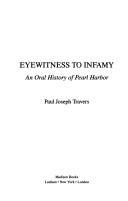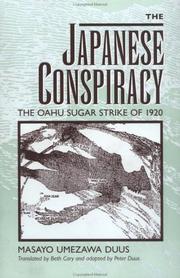| Listing 1 - 2 of 2 |
Sort by
|

ISBN: 1493023438 1493023446 9781493023448 9781493023431 9780819180582 0819180580 Year: 2016 Publisher: Guilford, Connecticut
Abstract | Keywords | Export | Availability | Bookmark
 Loading...
Loading...Choose an application
- Reference Manager
- EndNote
- RefWorks (Direct export to RefWorks)
"The Japanese attack on Pearl Harbor changed the lives of almost every American, and began the process of putting 17 million of them in uniform to fight in World War II. Yet in the long and fascinating body of literature about this terrible event, most historians have neglected the compelling and moving accounts of the surviving military personnel and civilians who were on Oahu at the time of the attack, at dawn on December 7, 1941. Eyewitness to Infamy is their story--the astonishing oral history of the brutal attack that pushed the United States into WWII on the side of the Allies: the British, French, and Russians. With the help of the Pearl Harbor Survivors' Association, the Veterans of Foreign Wars, and the American Legion, Paul Travers collected more than 200 eyewitness accounts from which he painstakingly selected those critical to this behind-the-scenes narrative account. With breathtaking clarity, the narratives cover the full range of military activity on the island, along battleship row, and around the harbor, while portraying the human side of the event--the heroic, the tragic, and the terrible reality of the assault"--Provided by publisher.
Pearl Harbor (Hawaii), Attack on, 1941. --- World War, 1939-1945 --- Oahu (Hawaii) --- History, Military

ISBN: 0520204840 0520204859 0520917677 0585331197 9780520917675 9780585331195 9780520204843 9780520204850 Year: 1999 Publisher: Berkeley, CA : University of California Press,
Abstract | Keywords | Export | Availability | Bookmark
 Loading...
Loading...Choose an application
- Reference Manager
- EndNote
- RefWorks (Direct export to RefWorks)
In early 1920 in Hawaii, Japanese sugar cane workers, faced with spiraling living expenses, defiantly struck for a wage increase to 1.25 per day. The event shook the traditional power structure in Hawaii and, as Masayo Duus demonstrates in this book, had consequences reaching all the way up to the eve of World War II. By the end of World War I, the Hawaiian Islands had become what a Japanese guidebook called a "Japanese village in the Pacific," with Japanese immigrant workers making up nearly half the work force on the Hawaiian sugar plantations. Although the strikers eventually capitulated, the Hawaiian territorial government, working closely with the planters, cracked down on the strike leaders, bringing them to trial for an alleged conspiracy to dynamite the house of a plantation official. And to end dependence on Japanese immigrant labor, the planters lobbied hard in Washington to lift restrictions on the immigration of Chinese workers. Placing the event in the context of immigration history as well as diplomatic history, Duus argues that the clash between the immigrant Japanese workers and the Hawaiian oligarchs deepened the mutual suspicion between the Japanese and United States governments. Eventually, she demonstrates, this suspicion led to the passage of the so-called Japanese Exclusion Act of 1924, an event that cast a long shadow into the future. Drawing on both Japanese- and English-language materials, including important unpublished trial documents, this richly detailed narrative focuses on the key actors in the strike. Its dramatic conclusions will have broad implications for further research in Asian American studies, labor history, and immigration history.
Strikes and lockouts --- Aliens --- Japanese --- Emigration and immigration law --- Labor & Workers' Economics --- Business & Economics --- History --- Legal staus, laws, etc --- Legal status, laws, etc --- Oahu (Hawaii) --- United States --- Japan --- Social conditions. --- Foreign relations --- E-books --- Ethnology --- Enemy aliens --- Expatriates --- Foreign citizens (Aliens) --- Foreign population --- Foreign residents --- Foreigners --- Noncitizens --- Resident aliens --- Unnaturalized foreign residents --- Persons --- Deportees --- Exiles --- Immigrants --- Refugees --- Combinations of labor --- Lockouts --- Work stoppages --- Direct action --- Labor disputes --- Strikebreakers --- Legal status, laws, etc. --- Hawaii --- Illegal aliens --- Illegal immigrants --- Non-citizens --- Unauthorized immigrants --- Undocumented aliens --- Undocumented immigrants --- History.
| Listing 1 - 2 of 2 |
Sort by
|

 Search
Search Feedback
Feedback About UniCat
About UniCat  Help
Help News
News